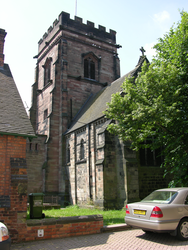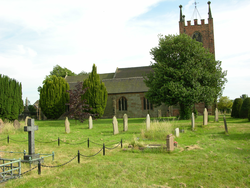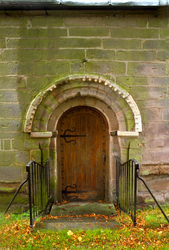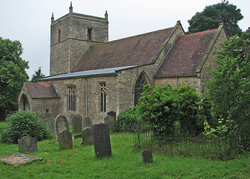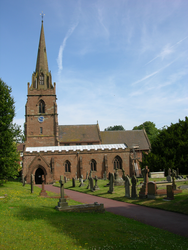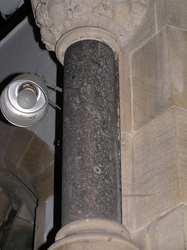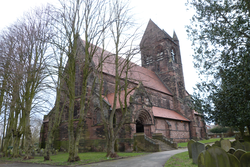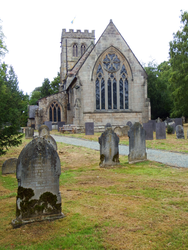
The Corpus of ROMANESQUE SCULPTURE in Britain & Ireland
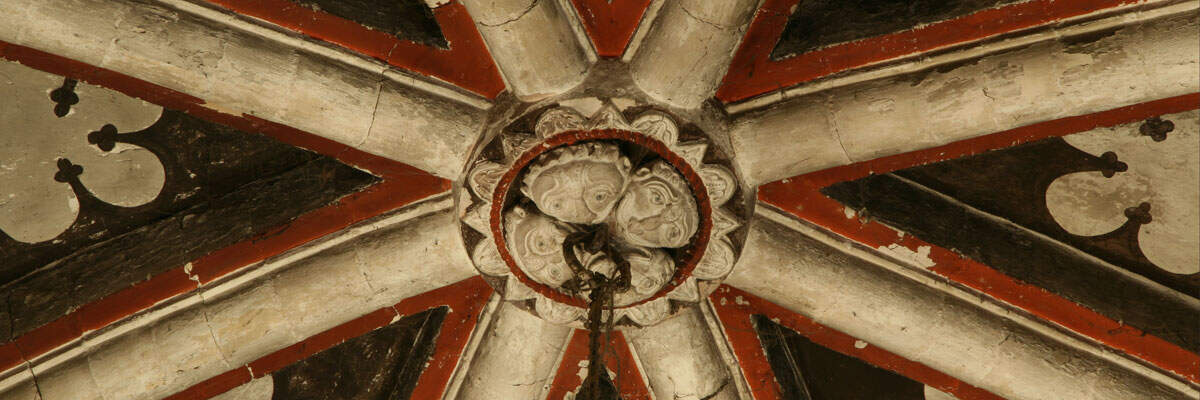
St Chad (now)
Parish church
St Chad's is on Greengate Street, one of Stafford's main shopping
streets running S from the market square. Its W front is entirely the work of
George Gilbert Scott (1873-74), but this conceals a church that is
substantially 12thc. and considerably larger than expected. It is cruciform
with a crossing tower and aisles to the nave. The
aisles have four-bay
arcades
carried on heavy cylindrical piers with scallop
capitals and chevron decoration on the two eastern
arches of each arcade. Above the E respond capitals and pier 1 capitals
on the nave faces of both arcade walls are attached
half-shafts rising to clerestory sill level, with plain cuboidal blocks where capitals and
bases would be expected. The W responds of the arcades
are of a later date than the rest, suggesting that the nave might originally
have extended further W, but the vicissitudes undergone by the façade
(see below) make this by no means certain. Above the arcades are round-headed clerestory windows; originally 12thc.
but entirely remade. The aisles are entirely Scott's work. The only nave
doorway is at the W. The crossing tower was rebuilt in
the 14thc. and restored by Robert Griffiths of Stafford in 1884, and all four
crossing arch heads are 14thc., although the
beautifully carved 12thc. W arch was retained, the new W crossing arch being constructed immediately to the E of it. In
the detailed descriptions below, the 12thc. arch is called the chancel arch. The N arch was rebuilt in the 19thc,
incorporating 12thc. carved capitals and imposts
discovered in the restoration. The E arch has 12thc. embrasures, capitals and
imposts supporting the 14thc. archivolts above. The S arch appears to be entirely 14thc.
work, but it is largely concealed by the organ. The N transept is by Griffiths
(1886) and now houses the Jevons Memorial Chapel, furnished in 1937. The S
transept was not rebuilt until 1953-55 and houses the organ with a
vestry behind it. The chancel
is now of three bays, with 12thc. windows in the two
western bays, original on the N side, and 12thc.
interior wall arcading in these bays on the N and S sides. The exterior chancel stringcourse also stops at the end of bay two, indicating that the 12thc. chancel was a bay shorter than the
present one. It may have ended in an apse.The architectural history is a complex one. Building must have begun in
the 1140s, and an inscription on an impost of the E
crossing arch attributes the foundation to Orm,
presumably Orm le Guidon, a major Staffordshire landowner married to the
daughter of Nicholas de Tosny. The tower was rebuilt in the 14thc., but
thereafter the building seems to have fallen into decline. By 1650 it was
ruinous. The aisles were pulled down at some time in the 17thc., and the
arcades bricked up. The transepts were also removed. In
1740 the W end of the nave collapsed, and in 1743 proposals for restoration
were received from Samuel Webb and from Richard Trubshaw. Trubshaw's estimates
were accepted, and his work was completed by 1745. He repaired the E
gable, refaced the nave walls in brick with stone
facings, inserted classical windows, rebuilt the parapet of the tower with urns
at the corners, and built an austere classical W front of brick (see Friedman
2001). He may also have been responsible for plastering over the carvings of
the 12thc. chancel arch. By the early 19thc. the tower
was in a dangerous state of disrepair, and by 1860 the churchyard had been
overbuilt with tenements and workshops, and a shop shut off the W front from
Greengate Street. The first of the 19thc. restorations concentrated on the
chancel. It was funded by the banker, Thomas Salt and
carried out from 1854 by Henry Ward (restorer of Armitage church). The plaster
was removed from the chancel arch, revealing the
sculpture; the 12thc. chancel windows were unblocked,
and a new E window was installed in a Geometrical style. Salt died in 1874, and
work began on the restoration of the nave in his memory. George Gilbert Scott
began this work, opening up the blocked S arcade, and
building an aisle on this side and a new W façade in a Romanesque style
to replace Trubshaw’s brick one. After Scott's death in 1878, Robert
Griffiths of Stafford continued the work to Scott's designs. He opened up the N
arcade, rebuilt the aisle and, in 1884, restored the
tower. In 1886 he rebuilt the N transept on the old foundations, and it was
while cutting through the tower wall to make this arch that the 12thc. carved
stones now incorporated in the N crossing arch were
discovered. The S transept was not rebuilt until 1953-55, when the present
organ chamber and choir vestry were added. The William
Salt Library holds three views of 1837 from the NE, by T. P. Wood and by
Buckler, all showing the nave without its N aisle, and with no sign of any
clerestory windows, and the tower before rebuilding, with urns at the corners
(SV.IX.112a, 112b, 113a). There is also an interior by Buckler of 1844, showing
the church without aisles and with the chancel arch
plastered over. Webb's and Trubshaw's proposals are illustrated in drawings in
the William Salt Library, Hickin Papers
319/2/40.
Parish church
Seighford is a small village only 2½ miles NW of the centre of Stafford. St Chad's is a curious mixture of brick and stone building. he W tower is of red brick and 17thc., with brick clasping buttresses and stone pinnacles added in 1748. This, or something like it, is also the date of the brick nave, but the chancel and the N nave aisle and its eastward extension to form a N chapel are of stone. The tower was built in the western bay of the nave, so that the W bay of the four-bay N arcade is alongside it. This end of the aisle has now been converted for use as a kitchen and lavatory. The arcade itself is 12thc. and the nave has no clerestory. The chancel arch is also 12thc., but the chancel contains a 13thc. piscina and nothing earlier. The arch to the N chapel is segmental and very broad, presumably rebuilt. The responds supporting it are Perpendicular (Pevsner reports the W respond as EE). The chapel is now occupied by the organ, with a vestry to the E. There are two antiquarian view of the church in the William Salt Library. A sepia wash drawing of 1838 by T. P. Wood shows its elevated position well in a distant view from the N (SV VIII 155a), and another sepia wash drawing by Buckler shows the church from the SE (SV VIII 156). Both show the building much as it is today. The only Romanesque features are the N nave arcade and the chancel arch.
Parish church
A two aisled church with a late 14thc. tower. The chancel is basically 12thc., but the S windows have been replaced and two on the N side of the chancel have been blocked. There are remains of the upper part of a large round arch over a later window in the E wall of the S aisle. Romanesque sculpture survives on the doorway to the N aisle. There is a badly eroded font which could be 12thc. and is therefore included.
Parish church
Harpswell in a small village in the West Lindsey district of Lincolnshire, 12 miles N of Lincoln. The church is siituated in the main street running south through the village, and is built of Limestone rubble with limestone ashlar facings. It consists of a W tower, nave with S aisle and S porch, and a rectangular chancel. The tower is 11thc. with long and short quoins and no buttresses, The nave has a 14thc tower arch and the arcade was added in the 13thc. The N wall was rebuilt in the 19thc., when the chancel was largely rebuilt too. The only Roamanesque feature is the font.
Parish church
Pattingham is in the SW of the county, close to the Shropshire border. The outer suburbs of Wolverhampton are only two miles away to the E, but the western prospect is of hilly farmland towards the Severn and the Shropshire Hills. The village centre retains some of its ancient charm, but the building of dormitory estates to the S and E has changed its scale and character significantly.The church is of red sandstone and has an aisled and clerestoried nave with a second aisle added on the N side, a chancel and a W tower with spire. The nave is very short; shorter than the chancel, but its aisles extend W alongside the tower, and E alongside the chancel. The inner N aisle is narrow, and the outer N and the S aisle are much wider. Making sense of this rather complex structure requires a chronological approach. The earliest surviving fabric is the two bay
arcade of the N inner aisle, which dates from the end of the 12thc. The church ofc.1200 must have had a chancel, and probably a W tower. In the early 13thc. the S aisle was added and the chancel was replaced by the present attractive Early English one. The next major change took place around 1330, when the tower was replaced and the S aisle rebuilt. The new tower arches to N, S and E were wide, opening the space up and effectively lengthening the nave. Around this time too, the S aisle was widened and lengthened; alongside the new tower to the W, and alongside the chancel to the E. All its windows are reticulated, and those of the chapel are larger than those in the nave aisle proper, but all the windows belong to the 19thc. restorations. A view by Buckler of 1846 (William Salt Library SV VII 158) shows the E window of the S chapel with reticulated tracery, implying that the mid-19thc. replacements were copies of the originals. The clerestory also dates from this period (it appears in the early-19thc. views), but it is heavily restored. There was a fire in Pattingham in 1665, but while the village was devastated the church seems to have escaped major damage. The church was comprehensively restored from 1856-93, largely thanks to the generosity of the patron, the 5th Earl of Dartmouth, and the vicar from 1844-1900, W. G. Greenstreet. George Gilbert Scott was involved in this work. The N outer aisle and the vestry were built, paid for by the vicar, the chancel, nave and S aisle were restored and the S porch added, and in 1871 the spire was built to Scott's design. Major restoration continued in the 20thc. The flying buttresses were repaired in the 1960s and the tower and spire in the '80s and '90s. Antiquarian drawings show the tower before the spire was added, with a low pyramid roof. The most interesting are those from the N, illustrating the elevation before the building of the outer N aisle. A view ofc.1800 attributed to R. Paddey (SV VII 160b) shows the church and the vicarage from the NE, and the original N aisle had apparently been widened and refenestrated at that time. The Georgian vicarage still survives. The only Romanesque sculpture is in the N nave arcade.
Parish church
The village stands at about 300m above the junction of two streams, the Nidd and the Stean. Looking SE from the church down Nidderdale, it is 7 miles (11.27 km) to Pateley Bridge.
The Victorian church, of 1865-6, has a chancel, nave with N aisle, W tower and NE vestry. The chancel arch incorporates Nidderdale limestone from Blayshaws quarry, about 1¼ miles (2 km) S. This limestone was used as ‘marble’ at Fountains Abbey in the 12thc, two polished capitals in the museum there being recorded for the Corpus.
The church was built in 1866 to replace one described as ‘a primitive looking building consisting of chancel, nave without aisles, a vestry at the west end, a south porch, a low tower not embattled, rising little above the long, low roof, which on the north side originally came down to within two feet of the ground’ (Speight (1906), 344); the ground rises abruptly on the N side of the church.
There is a large but incomplete 10thc cross reset in the church (Coatsworth (2008), 212-3).
Apart from the font, which may be of our period, there are no Romanesque remains to be seen at the church, but see Comments.
Parish church, formerly chapel
The previous church was a plain red-brick Georgian chapel of 1766, which may have been built on the site of the medieval church, itself replaced by a massive Neo-Romanesque building to its N built 1869-71 by Lancaster firm Paley and Austin. The two buildings were photographed together but the older building was soon demolished, and its site and small plan is still visible in the graveyard, marked by a monumental cross. The new building is a powerful and essay in Romanesque and Early Gothic, both sympathetic to period motifs and highly inventive. At the W end of the nave is the Romanesque font, which appears to be from the original building.
Parish church
Longford is a village in the Derbyshire Dales district, 8 miles W of Derby and 6 miles S of Ashbourne. The church stands in the grounds of Longford Hall, N of the village centre. It consists of a 4-bay aisled nave with a clerestorey and a S porch, a 5-bay chancel and a W tower. The nave arcades were originally 12thc, but both were modified in the early 14thc, and only the N arcade retains its Romanesque capitals and arches. The aisles were widened in the 14thc too, and the chancel was replaced. The clerestorey is 15thc work as is the W tower. Construction is of sandstone ashlar and (N aisle) rubble.
